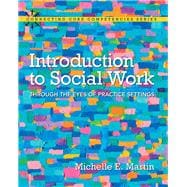Note: This is the bound book only and does not include access to the Enhanced Pearson eText. To order the Enhanced Pearson eText packaged with a bound book, use ISBN 0134057511.
Introduction to Social Work by Michelle Martin is designed to help readers understand the role and function of social workers within the context of a range of social service practice settings–child welfare, adolescence, older adults, mental health, homelessness, health care and hospice, school social work, religion and spirituality, violence and victim advocacy, and international social work. In it, readers learn to recognize a range of social problems impacting people within society, particularly members of at-risk and disenfranchised populations; understand key psychosocial and clinical issues impacting a range of populations within various theoretical frameworks; and apply key intervention strategies to case studies involving frequently encountered social problems and psychosocial issues. The text is consistent with the new CSWE EPAS, emphasizes ethical practice by infusing the NASW Code of Ethics throughout, integrates the use of technology, explores the role of religion and spirituality in the helping process, and examines social policy and legislation through a comprehensive history of related federal policy and legislation. The Enhanced Pearson eText features embedded video and assessments.
Improve mastery and retention with the Enhanced Pearson eText*
The Enhanced Pearson eText provides a rich, interactive learning environment designed to improve student mastery of content. The Enhanced Pearson eText is:
- Engaging. The new interactive, multimedia learning features were developed by the authors and other subject-matter experts to deepen and enrich the learning experience.
- Convenient. Enjoy instant online access from your computer or download the Pearson eText App to read on or offline on your iPad® and Android® tablet.*
- Affordable. The Enhanced Pearson eText may be purchased stand-alone or with a loose-leaf version of the text for 40-65% less than a print bound book.
*The Enhanced eText features are only available in the Pearson eText format. They are not available in third-party eTexts or downloads.
*The Pearson eText App is available on Google Play and in the App Store. It requires Android OS 3.1-4, a 7” or 10” tablet, or iPad iOS 5.0 or later.









